| Last Sunday, I attended a public meeting at 12.30pm in the John Paul II Hall at Marayong. It was all about the further development of Marayong on a number of possible areas of the overall site. These include the old Brother Albert hostel site (currently unused), the area formerly occupied by the Orphanage buildings (now demolished) or potential replacement of parts of the existing nursing home (ie north west wing). Although the CEO, Alexandra Davis, who has only been in the position about 12 months, and the Board members present, stated that a significant amount of advertising and notification had occurred in relation to the meeting, the 70 or so attendees insisted that insufficient information had been disseminated to relevant stakeholders and organisations in the Polish Community, given the important and significance of the matters being considered. Many examples were given, which could not be disputed. This was noted by all present.
As a town planner, it is understandable that I would like to see PLANS. Little more than a concept plan of the overall site, indicating which parts of the site were being considered for development, was shown to the meeting.
Although it was stated that DA documentation had been prepared in relation to the Child Care Centre, and the local (Australian) community notified and invited to a consultation meeting, it seems that no one within the Polish community had seen the plans for the Child Care Centre expansion which potentially could extend into the old Brother Albert site.
As I have also been in email contact with Ms Davis, I have since received a site layout plan of the Child Care Centre, so my level of information has increased. I thank Ms Davis for that.

Poniżej plansze przedstawione na zebraniu, przesłane emailem do Pulsu Polonii w dniu 21 grudnia 2016 |
The stated purpose of the meeting was that it is a preliminary consultation about development opportunities relating to the whole site, addressing the future needs of both aged care services and child care which are part of the Sisters’ core mission. In relation to aged care services, Ms Davis was trying to get feedback on such matters as room and bathroom sizes, layouts, built form (1, 2 or 3 storey?), number of patients per room, number of carers per patient etc.
Even though I currently have one parent in the new Brother Albert wing and another parent in one of the cottages, therefore affording me with some direct experience, I personally found it difficult to respond to such questions because I think it is easier when options are put in front of you. Also, as one of the attendees Ewa Latecka pointed (Ewa works as a private carer), many of these standards are set anyway by Government legislation and requirements, so the average person really has little to say about it.

Plany budowy/przebudowy zaznaczone na jasnozielono |
I think the questions related to issues of detail, which are hard to focus on when the broader and more strategic issues relating to the overall site are not resolved and agreed upon.
Many of the community members present talked a lot and passionately about the history of Marayong, how the Sisters had been invited by the Polish community to come and serve them, how the Church and facilities had been funded and built, about how the Polish heritage is so highly valued, the importance of the Church and the religious and cultural activities associated with the Parish. All of these things create a deep sense of “Polishness”.
I think it was Adam Gajkowski who pointed out that people have a choice and can go to equivalently well-appointed aged care facilities closer to where they live or where their children live, but want to come to Marayong because of that atmosphere of “Polishness”, and because it feels “right” for them to come here.
Many people also expressed how grateful they are to the Sisters for everything they do in terms of providing high quality aged care to the residents at Marayong, confirming the Community’s absolute satisfaction and unqualified support in this regard.
Questions were raised about the composition of the Board (Note: it is appointed by the Sisters) ie how many were Polish, and therefore presumably more likely to understand and sympathise with the needs and aspirations of the Polish Community. The answer to this question was that 2 members of the Board were not Polish however we were assured that they bring strong expertise to the Board in terms of aged care services, education and development. The Chairman of the Board, Leszek Madry, is of course Polish and has been associated with Marayong ever since he was a child. Also an experienced educator and musician, Leszek played the organ during mass for many years.
This raises the question, however, is being Polish sufficient, and is being associated with Marayong, sufficient?
You see, many people of my generation who were born here, even though they belonged to Polonia organisations as children and youth, thanks to the efforts of their parents, now have little to do with Polish culture and their children have little interest in speaking Polish or in their Polish heritage. These children are unlikely to form the future Polonia as they do not contribute in any way to what is happening in Polonia today. They are not connected to Marayong, and do not have an interest in its future.
Many "Wave 80" (Fala 80) Poles (not all) also encouraged their children to fully assimilate into the Australian community, pursuing qualifications and careers etc. and rather than maintain both cultures, in a sense rejected all aspects of their parents’ “Polishness”. The future of Polonia cannot rely on these people either.
So, if indeed the Polish community is to survive into the future and if indeed Marayong is to stay Polish, then new facilities at Marayong need to cater for and actively encourage cultural activities such as Polish dancing and Polish scouts which are currently associated with Marayong. These activities provide great opportunities for youth and children to learn about the Polish culture in an active and educational way, and need to be nurtured and further supported.
At this stage we are not clear on what will happen on the Marayong site. It could be a continuation of the status quo, or a minimal development scenario, or some form of more intensive development which could potentially fund some improved level of facilities to cater for cultural activities.
I put forward the idea of a youth cultural centre, somewhere for Polish youth from all of Sydney to call home. I wanted to raise that as a serious proposal.
If the Polish Community wants Marayong to stay a Polish Centre, then targeted planning and support of the most successful and proven cultural activities must be a part of that vision. If not, then the history and heritage associated with Marayong could simply become a little-known remnant of the past, which may or may not be remembered and appreciated.
Although I did set out to make this point at the meeting, I don’t think I made it adequately, and I thank Puls Polonii for providing me with an opportunity to further explain my position.
I hope that the Holy Family Services Board will take in all that was said at the Sunday meeting and be open to detailed and comprehensive consultation with the Polish Community about the further development of the site in a manner which will keep it Polish into the future.
Urszula Lang
| 

